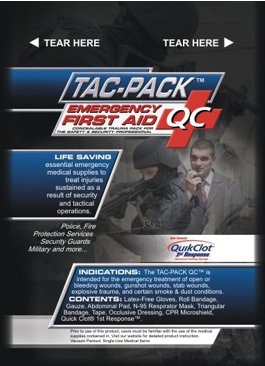First Aid for Hunting Sportsmen

Being prepared before you go out can mean the difference between an incident of minor discomfort, or a full fledged emergency.
You should have a modestly stocked first aid kit in your vehicle at all times, and you should have a pocket kit that goes with you whenever you go out in the field.
Think about what you are doing and then adapt and modify your personal rig for the circumstances. I live in Florida, and hunt around palmetto with its sharp teeth, sawgrass with its sharp edges, and wait-a-minute vines with their sharp thorns. I also have to contend with the fire ants, wasps, rattlers and cottonmouths. I don’t worry too much about them, but I get a lot of cuts and nicks. Now I’m not a big fussy type and most of the time I ignore the cuts and nicks. What I worry about are the deep slices and stabs I occasionally get from foolish mistakes I make, along with sprains to the knee or ankle. If you live up north then you might have different concerns, as would someone out west.
In your personal kit you should have:
* Ibuprofen, Aspirin and Benadryl.
* A cravat
* A couple of cloth bandaids
* Space blanket
* 20 feet of paracord
* A couple of yard size trash bags
* One freezer grade zip-loc bag.
Ibuprofen, aspirin and Benadryl. The Ibuprofen to help minimize inflammation and the Benadryl to counteract any allergic reactions. Aspirin for us older guys, just in case. Keep them in a 35mm film container, or buy one of those little packs they sell at the register and put three or four of each in the container..
A cravat - very helpful in plugging holes or holding pieces of you in place .The cravat makes a sling, bandage, eye cover, head cover, charcoal filter, pot holder, you name it. I consider it indispensible.
A couple of cloth bandaids, preferably the knuckle type. Cloth bandaids hold better and the knuckle ones work on every part of the body from fingertips to your rear end.
Space blanket. Just in case and it serves a dozen purposes from an emergency shelter to a signaling device.
20 feet of paracord. Splints, tiedowns, tourniquet, laces, lashing things together.
A couple of yard size trash bags. Those large yard trashbags can be made into emergency waders, raincoat, water hauler, bandage cover, or additional shelter.
That will all fit in a freezer grade zip-loc, and cover 95% of the injuries you might sustain.
Your vehicle kit should be a little more involved. Remember, your main purpose is to treat minor boo-boos, not perform surgery. Should you run into circumstances beyond your abilities, fall back to basic life saving techniques, stabilize the injured party to the best of your ability and get medical help at once!
The vehicle first aid kit should have back-ups of what is in your pocket kit plus:
- A dozen bandaids, again the cloth ones
- Antiseptic spray or liquid
- Antibiotic cream
- Self adhesive stretch tape. Totally great stuff!
- A half dozen sterile 3X3 or 4X4 pads
- Tweezers
- Space blanket
- Latex gloves
- Insect repellent
- Lidocaine or pain relief spray
- Pack of single edge razor blades
- Butane lighter
- Duct tape or 100MPH tape
 I recommend the addition of a Tac-Pack QC. In it is everything that you might need for a serious penetrating injury. And in this day and age it is an important lifesaving tool that you may be called upon to use in an emergency. Tactical Medical Packs(1-800-892-2801) will be coming out with a Hunter-Pack soon, which is very similar to the Tac-Pac QC. Again, as I frequently say, it is cheap insurance!
I recommend the addition of a Tac-Pack QC. In it is everything that you might need for a serious penetrating injury. And in this day and age it is an important lifesaving tool that you may be called upon to use in an emergency. Tactical Medical Packs(1-800-892-2801) will be coming out with a Hunter-Pack soon, which is very similar to the Tac-Pac QC. Again, as I frequently say, it is cheap insurance!There is also a very good PDF Tutorial by Dr. Maurizio A. Miglietta:
Trauma and Gunshot wounds: What you need to know to save a life.
Image Credit: RedCross GGR
 It's very important that when you have an opportunity to attend a first aid class, you do so without hesitation. Listen carefully, read the material given out, and practice your skills when possible. Occasionally refer to any good first aid manual to refresh your memory.
It's very important that when you have an opportunity to attend a first aid class, you do so without hesitation. Listen carefully, read the material given out, and practice your skills when possible. Occasionally refer to any good first aid manual to refresh your memory.A simple first aid kit packed with essential items is of utmost importance. It's not often that you are going to be presented with a a minor injury, much less a life threatening injury, but being prepared will make the former easy to live with and the latter easier to live through!
Regards,
Albert A Rasch
Member: Hunting Sportsmen of the United States HSUS (Let 'em sue me.)
The Hunt Continues...


